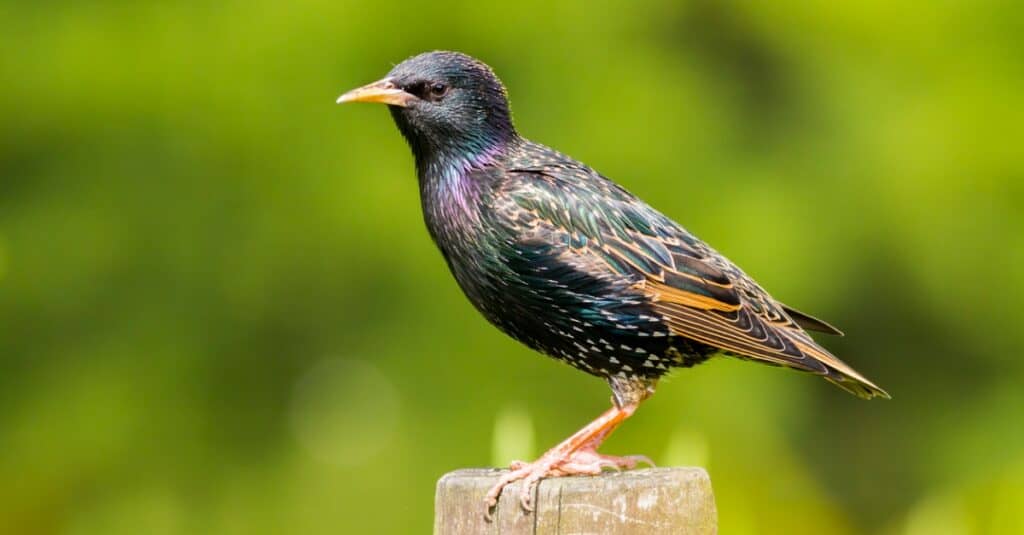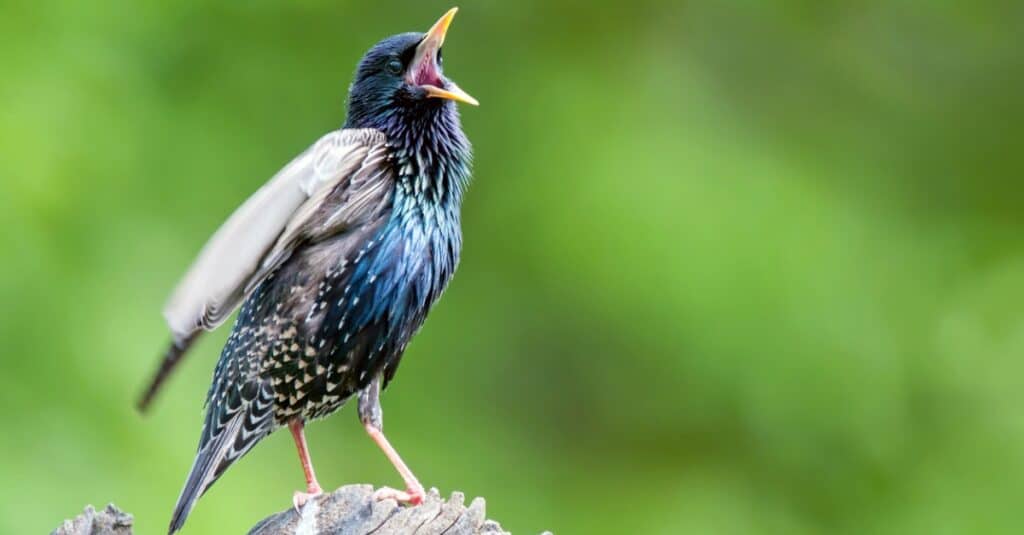Starlings are very interesting birds. Very gregarious, they often live in human habitats and are able to incorporate sounds from these habitats (even car alarms!) into their own calls. You might be curious, what do starlings eat?
Starlings are native to Asia, Europe, Africa, islands of the tropical Pacific, and northern Australia. Starlings have also been introduced to North America and New Zealand, where they are in competition with native birds for food. Thus, they are considered an invasive species in these areas.
There are approximately 110 species of starlings, all within the Sturnidae family. While there are subtle variations in diet, they mostly eat the same things.
What Do Starlings Eat?

Starlings mostly eat insects, although they also eat fruits, vegetables, grains, seeds, legumes, and nuts.
©iStock.com/chris2766
Starlings eat insects, including caterpillars, mealworms, and beetles. However, starlings are generally omnivores. They also eat fruits, vegetables, grains, seeds, legumes, and nuts. They also sometimes eat processed foods that humans usually eat. Urban starlings sometimes rely on landfills for their food.
Here is a list of the most common foods that starlings eat:
- Beetles
- Caterpillars
- Mealworms
- Crickets
- Grasshoppers
- Moths
- Flies
- Bees
- Earthworms
- Wireworms
- Weevils
- Snails
- Millipedes
- Centipedes
- Spiders
- Fruits
- Vegetables
- Grains
- Nuts
- Legumes
- Seeds
- Small animals, including baby birds
- Processed human foods
Although starlings primarily eat insects in all stages of life, they prefer larvae. A study of the Sturnus vulgaris starling on farmland showed that larvae made up at least 63% of what parent starlings would acquire for their nestlings.
About 58% of the adult starling diet is made up of invertebrates, such as insects. This is usually their preferred food. Insects provide all of the necessary nutrients, there’s usually a hefty supply of them, and they are a good size for the starlings to be able to pick up with their bills.
However, as previously stated, starlings eat more than just insects. They are already an invasive species in certain locations, so their omnivorous behavior has proven to be very damaging in some cases. For example, starlings have a history of stealing resources from farms; many farms have lost barley intended for cows to starlings.
Fruits give starlings many vital nutrients that they may not be able to get from insects. Because of their fructose content, they also give the starlings a nice energy boost.
Though starlings usually love seeds, there are seeds that starlings don’t like. They usually avoid peanuts within shells, thistle, safflower, and nyjer seeds. Starlings don’t have strong enough bills to break through most shells, so they’ll usually leave shelled seeds untouched.
What Effects Do Starlings Have on Ecosystems?

The eating habits of starlings cause destruction of plant species, but they also aid in seed dispersal and pollination.
©Soru Epotok/Shutterstock.com
In some cases, starlings can function as pest control, due to the high number of insects they consume. However, they have also been labeled as pests themselves because of the other foods they eat.
The fondness starlings have for fruits and vegetables makes them pests to people who are trying to grow these foods. They often pick out soft leaves or small shoots from vegetable plants, causing a lot of damage.
Starlings also have a tendency to rip flower buds from trees, causing quite a bit of damage on fruit plantations. They will sometimes bite off all of the fresh flower buds before the plants are able to pollinate and give rise to food.
In wild environments, starlings are very important for the reproduction of several plants. They feed on fruits, such as wild berries, and then they carry the seeds to different areas. This enables the plants to spread and grow. Starlings are important dispersers of the Indian Banyan tree in Asia and the white sandalwood tree in Africa, for example.
Some starlings are also important pollinators. For example, the slender-billed starling of alpine East Africa is known to pollinate giant lobelias.
What Do Baby Starlings Eat?

Baby starlings only eat insects; parents instinctively know their young need the high protein content in insects.
©iStock.com/Imogen Warren
While adult starlings have a diverse diet, starling chicks only eat insects. Insects contain a high protein content and have the ideal balance of nutrients for the growth of baby starlings. Their parents instinctively know this, which is why they exclusively feed their babies insects.
Parent starlings usually bring food items to the nest, accumulating a small stock to make sure that the chicks have enough food. Usually, both the mother and the father will play a role in making sure the chicks stay fed.
In the very early stages of life, parent starlings will regurgitate food back to the chicks. This food is usually going to be some mixture of soft-bodied invertebrates, such as millipedes, beetles, and crane fly larvae. Once they grow a little bit bigger and stronger, they will feed more independently on small pieces of insect and fruit, as well as seeds.
Baby starlings will eat larger and larger pieces of food until they are able to fly on their own and catch their own insects. Typically, starling chicks can eat on their own when they are about four weeks old.
What to Feed Starlings
If you want starlings on your property, it’s good to know that they can likely find a lot of what they want in your grass alone. Your grass is likely home to many beetles, worms, and other insects. Because starlings have strong legs, they have no problem hopping around your lawn to look for food.
If you want to feed starlings from your bird feeder, remember that they have relatively soft bills. Because of this, a softbill mix might be a good idea. This type of mix usually contains soft grains, mealworms, raisins, sultanas, and sunflower hearts.
You should also keep in mind that you may not want to be attracting starlings to your yard. People are typically more likely to want to repel them, since they have such a large repertoire when it comes to food and will often leave nothing for other birds.
Starlings have evolved to consume food in flocks, and being able to put away large amounts of food very quickly has proven to be an advantage for them.
What to Feed a Pet Starling
Starlings are not very common pets, but some people enjoy keeping them because of their ability to mimic sounds from the human world.
If you have a pet starling, make sure to give it lots of insects and healthy fruits. Your pet starling can also have grains, seeds, and leafy vegetables as supplements. Make sure your pet starling has access to fresh water as well.
The photo featured at the top of this post is © iStock.com/Michael Fitzsimmons
Thank you for reading! Have some feedback for us? Contact the AZ Animals editorial team.







